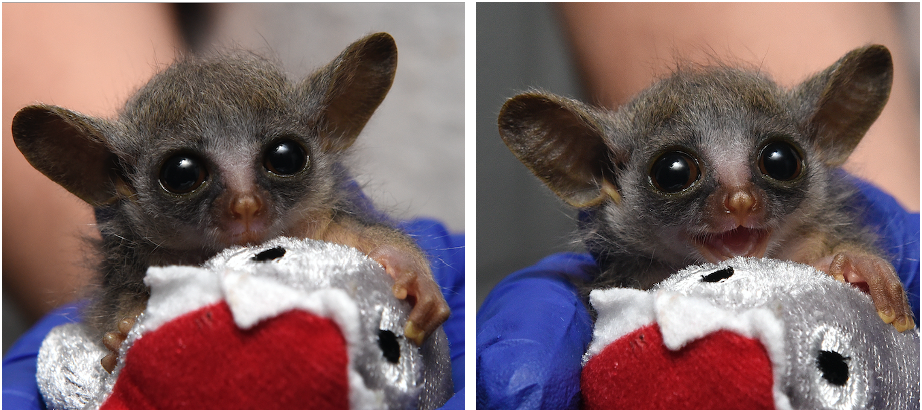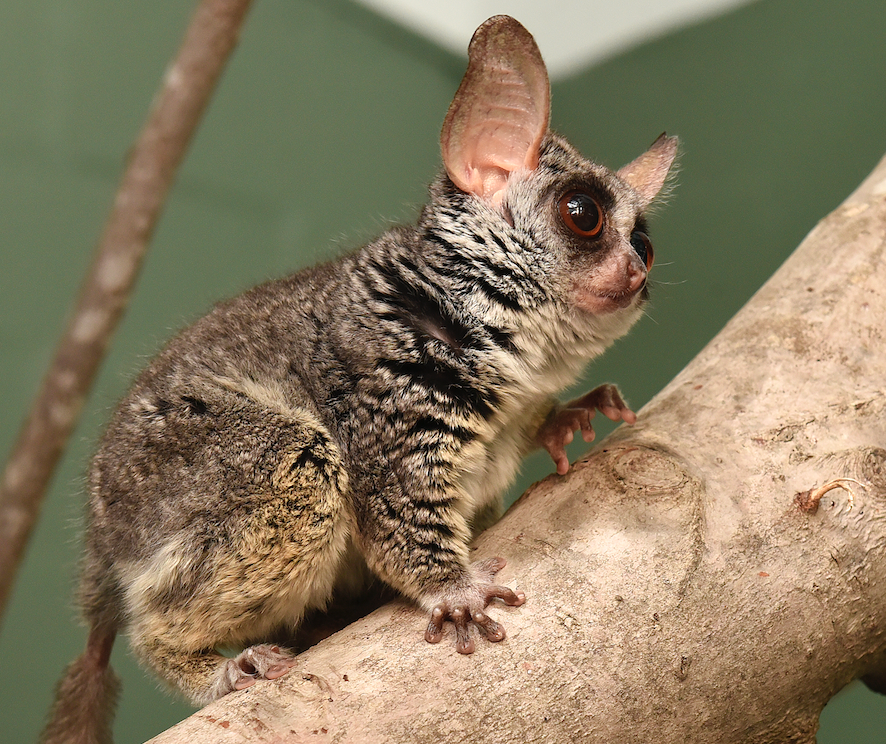
Coconut Palm is the first Mohol bushbaby born at the Duke Lemur Center and the second infant of Baby Week 2021! Photo by David Haring.
Bright-eyed and bushy-tailed, Coconut Palm is the first Mohol bushbaby (Galago moholi) born at the Duke Lemur Center in more than five years!
Bushbabies are the only non-lemur primate species currently housed at the DLC, so learning how to best care for Mohol bush babies has been a fun project for our experienced staff. Having a full year’s experience with the four adult bush babies that call the DLC home, the staff felt comfortable allowing male Baobab and female Quiver Tree to breed, as had been recommended by the Species Survival Plan (SSP) for this species. Working with other facilities, animal care staff make recommendations for which animals should produce offspring to make sure there is always space and good genetic diversity for animals in human care.
Coconut Palm was born in the early hours of March 3, 2021. Since infant bushbabies do not cling to their moms as most lemurs do, staff had to assume that Quiver Tree had given birth by how quickly she ate her breakfast before darting back into her cozy nest. To not stress the nervous first-time mother, staff took turns observing her enclosure using cameras placed inside the room. Finally, they saw what they were waiting for: a fuzzy, ping-pong ball-sized infant carried gently out of the nest by mom and placed on a branch while she searched for food.

At nine days old, Coconut Palm was about the size of a ping-pong ball… and just as bouncy! Bushbabies move by propelling themselves with powerful legs, jumping quickly from branch to branch. Photos by David Haring.
At his first checkup, Coconut Palm weighed just half an ounce, a healthy weight for a newborn of this small primate species. Since Coconut Palm is an only child, he has grown quickly. Mom is able to focus all her attention on feeding, grooming, and communicating with her adorable infant.
Bushbabies are named for their alarm call, a loud vocalization that can sound like a human infant crying. Since Coconut Palm’s birth, staff has gotten to know the call firsthand as there has been no shortage of vocalization between mother and baby. Bushbabies park their infants on branches or hidden in nests while they travel during the night, using their piercing vocalizations to update each other about where they are when they cannot see each other visually.

Quiver Tree spends most of her day looking for insects with her large ears and eyes. While she is away from the nest, she communicates with Coconut Palm through vocalizations. Photo by David Haring.
Join us for BABY WEEK 2021!
The Duke Lemur Center has welcomed numerous infants this summer through our conservation breeding program, and we’re announcing five—yes, FIVE! —of the newest babies this week!
Here’s how to make sure you don’t miss ANY of these special announcements, or the accompanying photos and videos:
Meet our other BABY WEEK 2021 infants:
Ring-tailed lemurs Scout and Atticus
How you can help Mohol bushbabies
Send a “baby shower” gift: Make a lemur’s day by sending a special gift in Coconut Palm’s honor via the DLC’s amazon.com wishlist!
Contribute to little Coconut Palm’s “scholarship fund”: Did you know it costs $8,400 per year to care for one animal at the DLC—including little Coconut Palm? We rely upon donations from individuals like you, who personally invest in our work to care for lemurs and protect their habitat in Madagascar. To learn more about the DLC’s “return on investment,” please see our stewardship booklet and 2020 director’s report.
A heartfelt THANK YOU for your support —we couldn’t do this work without you!

